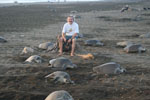Southeastern biologist leads international meeting in New Orleans focused on sea turtle conservation
Monday, April 14, 2014 
by: Rene Abadie
TURTLE WATCH -- Sea turtle expert Roldán Valverde, an associate professor of biological sciences at Southeastern Louisiana University and current ISTS president, sits among hundreds of sea turtles on a Costa Rican beach where he conducts research. The turtles come to the Latin American nation every year to build their nests.
HAMMOND – A Southeastern Louisiana University biologist is lending his expertise to scientists gathering to study the global issue of short and long term environmental impacts on marine life.
"We're now approaching the fourth anniversary (April 20) of the worst accidental marine oil spill in the history of the U.S., and we're still assessing its effects on Gulf marine life," said sea turtle expert and Southeastern Associate Professor of Biological Sciences Roldán Valverde.
Currently the president of the International Sea Turtle Society (ISTS), Valverde is coordinating the 34th Annual Symposium on Sea Turtle Biology and Conservation, where a group of several hundred scientists, conservationists, students and others will meet in New Orleans April 10-17 to address their common interests and objectives: the conservation of sea turtles and their environment.
Other topics included in the program are threats to sea turtle habitats, impact of fisheries bycatch, oil spills, climate change, and urban development in coastal areas. Special workshops will also be offered on sea turtle rehabilitation and health as well as on curriculum development on sea turtle conservation for K-12 educators.
Sea turtles—a group of seven species thought to have evolved more than 200 million years ago—are currently under significant stress, especially in the Gulf of Mexico, primarily as a result of human negligence and industrialization, explained Valverde.
Valverde said this is the first time the ISTS is meeting in New Orleans, and he sees this as an ideal opportunity to call attention to deterioration of the once abundant sea turtle populations in the Gulf. He and fellow scientists are still tallying the damage to the sea turtle population attributed to the Deepwater Horizon oil rig explosion.
How did the largest accidental marine oil spill affect the Gulf's sea turtles? Valverde and his fellow scientists have found the basic question difficult to answer because they lack precise historic data on turtle populations, particularly in Louisiana waters.
"In the Gulf of Mexico, the population of all the sea turtle species tends to be lowest in the north central Gulf of Mexico, around Louisiana, Mississippi and Alabama," he said. "Certainly, these states were among the hardest hit by the oil spill. The reasons behind the decline are unknown, but signs point to industrial development and fisheries bycatch, combined with the lack of suitable nesting habitats."
Valverde said after the oil spill, many turtles were brought to the Audubon Zoo in New Orleans and other Gulf sites to recover.
"Many of these turtles were covered with oil, and many had ingested oil," he explained. "But if we say the spill was responsible for sea turtle deaths, we're asked for numbers. Nobody really knows because there weren't previous studies to determine the population status of the various species."
Valverde and other scientists are currently working to establish new population baselines in the Gulf of Mexico so scientists can use the data to determine impacts of disasters and changes as they occur in the future. He said the only turtle data currently available as far as impact from the oil spill is what was collected by the National Oceanic and Atmospheric Administration, which determined that about 600 turtles had died during the spill.
"But that is only what was physically seen and counted," he added. "In actual fact, probably thousands of turtles died due to the spill. We could not count those because they probably sunk to the bottom of the Gulf before they could be counted."
There are five sea turtle species that inhabit the waters of the Gulf of Mexico, and all are considered endangered. Among them, the Kemp's ridley sea turtle is considered critically endangered.
Sea turtles spend most of their lives in the oceans and open water, and females return to beaches to build their nests and lay eggs. While Louisiana is not a nesting ground, Valverde said it is an important area for the growth, development and feeding of these turtles. Most of the nesting takes place in Florida, Central America and the Yucatan Peninsula.
A major concern, he said, is that the sea turtle populations may eventually disappear from the Gulf of Mexico due to human negligence.
"This could cause significant impact on our marine ecosystem that we cannot predict at this point because we lack the data on how these species contribute to our ecosystem," he added.






